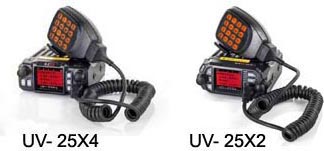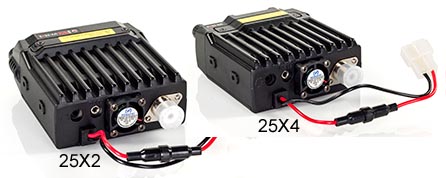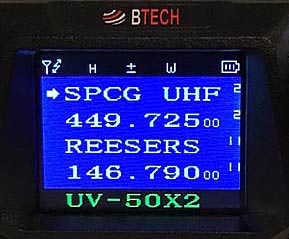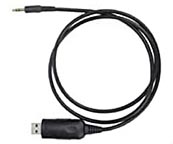Ham Radio - Camera -
Computer - F8HP - UV5R - Baofeng - Pofung
Product Review
25X4 25X2
Version 2


by: John 'Miklor' May 2023
Product Review
25X4 25X2
Version 2

by: John 'Miklor' May 2023
|
General Description
This is a review of the new 25W Dual and Tri-Band offerings from BTech. The new BTech series not only a new case and screen design, but several options not found in other similar appearing radios. For this review, I actually did a side by side comparison against the 'other' brand to determine there is a definite difference between their offerings. Looks are deceiving. There are several options and features that you won't find in other brands. Described below is a description of the additional features that have been added to this design. There are actually 3 radios in the 'X-series', but this review will focus on the 25W mobiles, the 25X2 and 25X4. Version 2 Additions * Second Generation The UV-25X2 and 25X4 have seen several performance improvements and tweaks in its second generation release. RJ45 Audio Input & Output They both have new menus and operations that allow audio I/O from its RJ45 microphone port. This allows the mobiles to be installed for custom applications, where users want more control on where the speaker and mic audio is routed to. VOX Hands Free Support The UV-25X2 and 25X4 (Second Generation) include VOX support. VOX allows for handsfree use with your favorite audio accessories or the included handheld microphone. In the Box Included with the radio are: - Microphone with a 16 button keypad - Chrome metal microphone hanger - Metal mounting bracket with screws - DC Power Cable with lighter/accessory plug - Full 78 page User Manual (English) They weigh in at a hefty 14.4 oz (408g) Chassis Size is 3.9" (W) x 1.4" (H) x 4.6 (D)" (98 x 35 x 118 mm) Specifications These are full 25W 200 channel transceiver that supporting several new options, including display synchronization, microphone gain control, the ability to alter channels on the fly without the need for software, frequency randomization, and a few others. A full specifications can be found HERE Enclosure and Mount The main chassis weighs in at just under 1.0 lb with a top finned heat sink and cooling fan in the rear. The radios are terminated with a standard SO-239 connector.
Transmitter I used my 13.8VDC power supply to emulate a standard auto battery. On VHF and UHF, both radios were within 1W of each other running into a calibrated Bird Wattmeter.
Microphone & DTMF Gain Controlling One of the newly added features added to the X series not found in similar appearing models is a microphone gain control. Using the software, I can now advance the transmit audio gain for operation at home so I can speak back from the microphone. I can also reduce the gain for mobile operation to avoid picking up road and background noise. There is plenty of gain so caution should be used not to set the gain too high.se levels can actually be set too high. My audio reports and quality were excellent. Along with the microphone gain, there is also an option to vary the DTMF gain. I found this extremely helpful for accessing IRLP networks. Receiver / On Screen Scanning Unlike some transceivers, the radios have have both Wide and Narrowband receivers, depending on the mode selected with a 2W audio section that provides plenty of volume. The entire X series has the ability to display four frequencies on its new display. The TMR option (Transceiver Multi-Receive) allows any 2, 3, or 4 displayed channels to be selected for 'on screen' scanning. If a selected channel becomes active, the display will lock onto that channel and remain there for a predetermined amount of time before resuming the scan. This is a great option when traveling to a new area and not knowing which repeaters are the most active. The scan rate is 3 to 4 channels per second. Fast enough to go through the four channels and not miss a call. Channel Scanning Normal channel scanning is still available with a little added bonus. I can now add or delete a channel from the scan group on the fly. This eliminates my need to reprogram using software to make minor change. Another option I found was the ability to set the scan mode to start or resume immediately upon power up. This saves a few steps if you like to keep your radio in the scan mode. Display / Display Syncing The new face design includes a much improved OLED* display (1 3/8 x 1 1/8") with nine color choices that can be configured in any combination of your choice. The available colors are Black, White, Red, Blue, Green, Yellow, Indigo, Purple, and Gray, giving virtually thousands of color combination possibilities. I found the resolution of the new OLED display outstanding. Regardless of the color, the display is bright and extremely clear. No more squinting. My iPhone didn't capture the display image as well as I had hoped, but this will give a rough idea of some various color combinations. * Organic Light-emitting Diode * The 25X2, 25X4 and 50X2 all share the identical OLED display.
Now, this is the part I like best. The X series has display synchronization. I can select display pairs. (A/B, C/D, or A/B C/D) and pair them together. When changing channel, the selected pair tracks together, displaying both the repeater name and frequency. That gives me the best of both readouts. The screen clarity is amazing.
Programming One new capability I found extremely helpful was the ability to change channel parameters such as tones, power, and 'scan add' via the keypad, without the need for deleting and reentering the channel data. The programming software for this radio is CHIRP. The advantage here is CHIRP's compatibility with over 160 different models of radio, so if you currently have a transceiver programmed with CHIRP, all that is needed is to create a template of the new radio, and a simple cut and paste of your channel list. If you are new to CHIRP software, there are guides and examples available HERE.
Channel Randomization Here's a unique special purpose option. It allows what is known as frequency hopping and requires two X series radios. The four channels in the display can be set to four different simplex channels. The same channels must be set in the same sequence in both radios. Each press of the PTT moves the radio to the next channel. A, B, C, D, A, B, etc. As long as you identify the first time you use each channel and again every 10 minutes, you should be fine. It's a bit tricky to set up, but it works. Mobile Power Cable All power cables are not created equal. If your radio has a maximum output of 25W, it will require approximately 5-6A from your battery or power supply. This is well within the range of the average cars accessory socket which is normally fused at 10A. My test radios drew a fraction under 6A on transmit. If you are using a radio that runs 50W, such as the 50X2, it is going to draw between 10-13A, requiring a connection directly to the battery or fuse block. Base Station Operation When choosing a power supply for base station operation, a 50W (11-12A) requires a power source capable of 15-20A continuous (not just surge) for proper operation. A 25W (5-6A) will require a power source of at least 8-10A continuous. An insufficient power supply put strain on both the supply and radio resulting in damage or equipment failure. Here are a few power supply Examples that may assist. In Summary It looks like BTech took a great design and took it to the next level. It is based on a proven design, and I have found no issues with the radio while testing. The newly added features found in the X series includes: - Memory modifications on the fly - Display synchronization - Adjustable microphone gain - Frequency randomization - Scan resume options - Scanning start / return on Power On BTech had its act together when they designed the firmware for the X series. Here is a link to their big brother, the UV-50X2 Review Note: This equipment was received for the purpose of a fair and unbiased review. All findings are factual based on the equipment I received. Any issues found have been reported both here and back to the seller or manufacturer.
 |
 UV-50X2 50W Dual Band -Review-  UV-25X4 25W Tri Band -Review-  UV-25X2 25W Dual Band -Review- ^ PC04 ^ Programming Cable (for above)  UV-50X3 Tri-Band -Review- ^ PC05 ^ Programming Cable (for above) |









